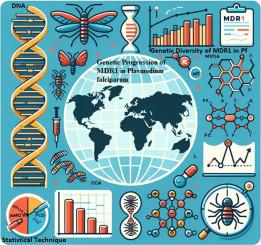探索恶性疟原虫 MDR1 的遗传进展:多区域遗传分析十年(2014-2024 年)
IF 4.8
Q1 MICROBIOLOGY
引用次数: 0
摘要
背景恶性疟原虫的 MDR1 基因是产生抗药性的关键因素,其遗传进展给疟疾控制工作带来了重大挑战。本研究旨在阐明恶性疟原虫的遗传多样性和进化动态,尤其侧重于跨区域种群的 MDR1 基因。方法我们使用分子方差分析(AMOVA)、Nei无偏遗传距离和同一性的配对种群矩阵、PhiPT和Phi'PT值以及主坐标分析(PCoA)等方法进行了广泛的遗传分析。研究覆盖了来自印度、尼日利亚、埃塞俄比亚、洪都拉斯、中国和喀麦隆的不同恶性疟原虫种群。我们的研究结果表明,MDR1 基因具有显著的遗传异质性:Odisha(2014 年)等位基因丰富度较高,表明耐药性特征多样。我们观察到显著的遗传差异,尤其是印度(2016 年)和尼日利亚(2020 年)之间的差异,这表明耐药性的进化轨迹不同。PCoA 分析凸显了多维遗传变异,反映了影响恶性疟原虫耐药性的各种因素之间复杂的相互作用。这些知识对于制定有效的疟疾控制措施和调整治疗策略以适应寄生虫不断变化的遗传多样性至关重要。本文章由计算机程序翻译,如有差异,请以英文原文为准。

Exploring the genetic progression of MDR1 in Plasmodium falciparum: A decade of multi-regional genetic analysis (2014–2024)
Background
The genetic progression of the MDR1 gene in Plasmodium falciparum, a key factor in drug resistance, presents significant challenges for malaria control. This study aims to elucidate the genetic diversity and evolutionary dynamics of P. falciparum, particularly focusing on the MDR1 gene across multi-regional populations. To analyze the genetic diversity of P. falciparum MDR1 gene across various multi-regional populations between 2014 and 2024, assessing allelic richness, genetic distances, and evolutionary patterns.
Methods
We conducted an extensive genetic analysis using methods such as Analysis of Molecular Variance (AMOVA), pairwise population matrices of Nei unbiased genetic distance and identity, PhiPT and Phi'PT values, and Principal Coordinates Analysis (PCoA). The study covered diverse P. falciparum populations from India, Nigeria, Ethiopia, Honduras, China, and Cameroon.
Findings
Our findings reveal significant genetic heterogeneity in the MDR1 gene. Populations like India: Odisha (2014) exhibited high allelic richness, indicating diverse drug resistance profiles. Notable genetic divergence was observed, especially between India (2016) and Nigeria (2020), suggesting different evolutionary trajectories in drug resistance. The PCoA analysis highlighted the multi-dimensional genetic variation, reflecting the complex interplay of factors influencing drug resistance in P. falciparum.
Interpretation
The comprehensive analysis of P. falciparum's MDR1 gene provides crucial insights into the multi-regional patterns of drug resistance. This knowledge is essential for developing effective malaria control measures and adapting treatment strategies to the evolving genetic diversity of the parasite.
求助全文
通过发布文献求助,成功后即可免费获取论文全文。
去求助
来源期刊

Current Research in Microbial Sciences
Immunology and Microbiology-Immunology and Microbiology (miscellaneous)
CiteScore
7.90
自引率
0.00%
发文量
81
审稿时长
66 days
 求助内容:
求助内容: 应助结果提醒方式:
应助结果提醒方式:


